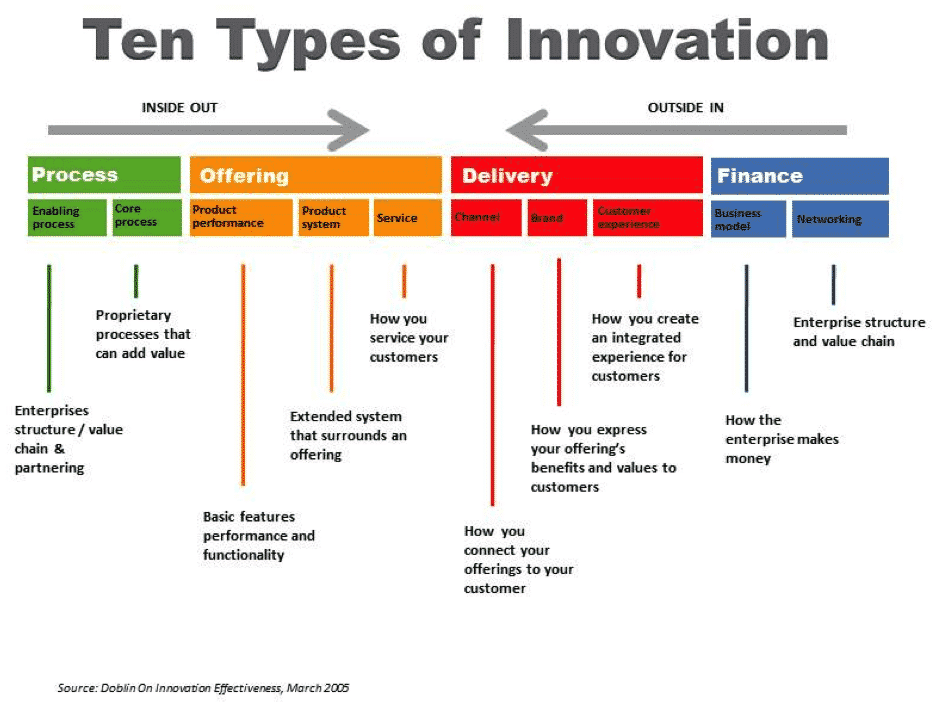Sustainable Innovation Meets Disruptive Innovation

Why is success so hard to sustain?
In order to succeed, everybody should be involved and engaged in innovation. Innovation should be broad; from innovations in the product or offering, to innovations in the process, delivery, and/or finance.
For many years, innovation was seen as the development of new products. However, creating new products is only one way to innovate. “Initially developed in 1998, the Ten Types of Innovation showed that companies that integrate multiple types of innovation will develop offerings that are more difficult to copy and that generate higher returns.” – Doblin Group
Most Innovation research is focused on Product Performance. We as consumers admire the latest gadget, and seek to attain the “next big thing”. Innovation leaders and inventors often pursue innovations at the higher tiers of their markets because this is what has historically helped them succeed. However, according to Doblin’s research, there are more opportunities to create competitive advantage in the other types of innovation. In many cases these innovations may be more cost effective, and can even generate a higher rate of return.
I recently met Dr. Smith, Dentist in Memphis who really got the idea of service innovation in business. He offers his services in-office or from the comfort of the clients own home. A dentist that comes to you… what a novel innovation in the delivery of such a service. By taking his practice on the road, he has the ability to visit clients who were previously unable to see a dentist, such as seniors living in nursing homes, or those with unable or unlikely to take the time out to drive for a teeth cleaning.
Not only that but he raised the awareness with his service vehicle in sharing a great smile and catchy wheel covers that do get your attention. I just hope he behaves on the road, hard to be smiled at when cut off J
Much like Doblin’s innovation theory, Clayton Christensen, Professor of Business Administration at the Harvard Business School suggests another type of innovation as well; disruptive Innovation. According to Christensen, successful companies can put too much emphasis on customers’ current needs, and fail to adopt new technology or business models that will meet customers’ unstated or future needs.
A disruptive innovation is one that creates a new market by applying a different set of values, which ultimately (and unexpectedly) overtake an existing market. Disruptive innovation allows access to a product that was historically unattainable to the majority of consumers (usually because it was overly complicated, too expensive, or inconvenient). With disruptive innovation, access is given to a new and potentially larger population at the bottom of the market.
Going back to the topic of dentistry, Procter & Gamble’s Crest® Whitestrips® product provides a great example of a disruptive approach that created an entirely new market by targeting non-consumers: those who find it too inconvenient or expensive to go to the dentist for teeth whitening. In the same fashion, by taking his practice on the road, the Memphis dentist I met is creating a disruptive innovation in a market previously disregarded.
 According to Innosight, “disruptive innovation isn’t about winning a technology race, but about delivering innovations aimed at a set of customers whose needs are being ignored by industry leaders. A disruptive innovation trades off performance along one dimension for performance along another, such as simplicity, convenience, ability to customize, or price.
According to Innosight, “disruptive innovation isn’t about winning a technology race, but about delivering innovations aimed at a set of customers whose needs are being ignored by industry leaders. A disruptive innovation trades off performance along one dimension for performance along another, such as simplicity, convenience, ability to customize, or price.
This arguably creates the innovators dilemma. Do you create better products that you can sell for more money to your current consumer, or do you create a disruptive innovation which targets those, who may not be your consumers yet, focusing on simpler products at lower price points?
Before beginning your next innovation effort, here are some key questions from to consider for mapping out an effective innovation plan.
- What type of innovation does your organization need?
- Does your innovation satisfy customer needs?
- Who are your innovation champions?
- How will you measure success?
- How will success be rewarded?
Category : Innovation



